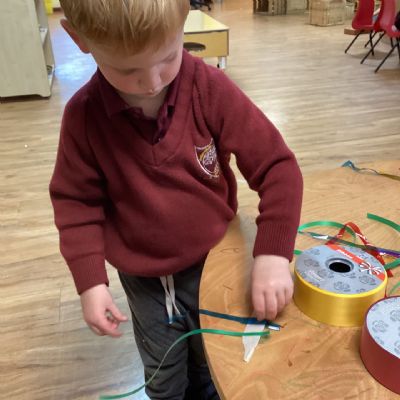Autumn
Nursery
In this topic, children will:
- Know how to make imaginative and complex ‘small worlds’ with blocks and construction kits
- Name materials such as cardboard boxes, wall paper, cardboard, sequins, paper, tissue paper, felt
- Name different tools for cutting and joining e.g.scissors, masking tape, sellotape, pva glue, pritt stick, and use these in their work
- Explore scale when making
- Know how to use tools safely e.g. scissors, hole punch, pencil
Reception
In this topic, children will:
- Name materials such as cardboard boxes, wall paper, cardboard, sequins, paper, tissue paper and decide which ones to use in their work
- Know different techniques for joining materials and use them in their work e.g. adhesive tape, different types of glue
- Know how to use a range of tools with increasing care and precision e.g. scissors, hole punches, glue sticks, sellotape
- Know what crafts people do e.g. potter or bushcraft and use ideas from what they have learnt in their work
- Know why tools need to be used safely and how to transport and store them
- Create collaboratively, sharing ideas, resources and skills

In woodland learning, the children learn how to wrap string around wood.

Year 1: Make a card
In this topic, the children will:
- Know that mechanisms produce different types of movement
- Know that sliders and levers are mechanisms
- Know the movement of a slider and a lever and demonstrate how one is constructed
- Know how to follow their design to make a card with a lever and/or slider mechanism

In woodland learning, children learn how to tie an over hand knot.

Year 2: Make a wheeled toy
In this topic, children will:
- Know the terms wheel, axle and axle holder
- Know the purpose of a wheel, axle and axle holder and demonstrate how these are used
- Know the difference between fixed and freely moving axles
- Know how to apply their knowledge of wheels and axels to make a wheeled toy

In woodland learning, children learn how to tie a bow knot.

Year 3: Make sandwiches
In this topic, children will:
- Know that a healthy diet is made up from a variety and balance of different food and drink, as depicted in ‘The Eat well plate’
- Know how to use a range of techniques such as chopping (claw & bridge) peeling, grating and spreading
- Know that food can be grown, reared, caught and processed
- Know where the ingredients come from (e.g. ham from a pig)
- Know how to apply their knowledge of food preparation and healthy eating to make a sandwich

In woodland learning, children learn how to tie a figure of eight lashing.

Year 4: Make a gift box
In this topic, children will:
- Know what a shell structure is
- Know what a net is and use knowledge of nets of cubes and cuboids and, where appropriate, more complex 3D shapes
- Know how to construct strong, stiff shell structures
- Know how to manufacture a shell structure based on their generated design

In woodland learning , the children learn how to tie a reef knot.

Year 5: Make bread
In this topic, children will:
- Know how to use and select appropriate equipment and utensils to prepare and combine food
- Know the origins of the ingredients needed e.g. flour
- Know the term seasonality and demonstrate through their ingredient choices
- Know how make bread, based on their design following a recipe

In woodland learning, children learn how to tie a timber hitch knot.

Year 6: Make a phone case
In this topic, children will:
- Know that a 3-D textile product can be made from a combination of accurately made pattern pieces, fabric shapes and different fabrics
- Know how fabrics can be strengthened, stiffened and reinforced
- Know how to use blanket stitch and back stitch
- Know how to make a phone case based on their generated design

In woodland learning, children learn how to tie a siberian hitch knot.




